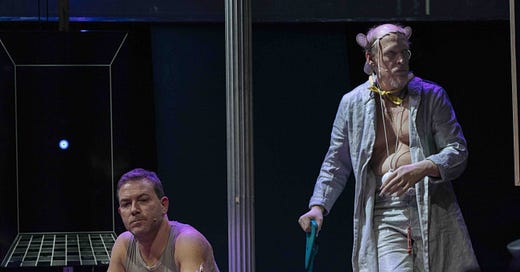First, there is the set, which is the first thing you see upon entering the theatre. Hardly a thing that spurs any sense of aesthetic wonderment or reverie, it is nonetheless very much in keeping with the style of most of the sets of Wooster Group productions I have seen over the years – and, for that matter, the handful of productions by Richard Foreman’s Ontological-Hysteric Theater I was fortunate enough to have witnessed. Which is to say: a non-set, a workmanlike anti-structure, bisected by ropes strung at certain angles, furniture arranged into planes: wooden furnishings clearly selected for their shapes and placed according to some strange and intriguing compositional logic. A site of worn dilapidation, foregrounded with two long tables. The one on the right has what looks to be an upturned basketball hoop – it will turn out to be a framing device for the visage of one of the performers – the one on the left, a laptop computer. To the right rear of the stage, a rhomboid painting hangs beneath a cheap light, beside that a chalkboard adorned with scrawl. Center rear, a basketball erected on a thin column resembling an extra-long paper towel roll. To the left hangs a soccer ball, to the left of that an arrangement of easels with covered canvases; behind that, some more tables. Overall, a homey, homely semi-construction site of an environment; a remnant, perhaps, of the visual art in fashion in the downtown New York that spawned the Wooster Group in the 1970s – Robert Morris, the Minimalists. Hardly anything to excite or incite the violence of the imaginary.
Perhaps this is the very pre-show deception required to effectively propel us into the psycho-sphere in which we’re about to be immersed. Having watched the show twice at this year’s Biennale Teatro in Venice – where the Wooster Group’s director Elizabeth LeCompte was awarded the Golden Lion for Lifetime Achievement by this year’s artistic director (and former Wooster Group member; and LeCompte’s former partner) Willem Dafoe, in a poignant ceremony – I can happily report that I still have no idea what the play is about. This aboutness is very much beside the point of both Foreman and the Wooster Group’s approach to theatre. What I can relay to you is what is given to us, the audience, in the first scene: a departure point. The President of the United States, the sole named character, is receiving messages from an unknown, possibly extraterrestrial source. What spools out from this premise, over the next seventy-five minutes, is a textual ballet of irrational impulses, thoughts and words collaged into a staged poem comprised of movement, sound, spoken exchange, song.
Plot is a crutch; when it does exist, it should always be murky, convoluted, unsummarizable – the opposite of the proverbial three- (or five-) act structure. If it is too easy to be discerned, then it ceases to be art, becomes mere entertainment – which is fine, perhaps, for certain scenarios, but not for the type of theatre that the Wooster Group has been engaged in deploying for the past forty-odd years. The pairing, here, with Foreman, makes a lot of sense. Although she began as a disciple of Richard Schechner, it was seeing Foreman’s plays, LeCompte said, that confirmed for her that she could begin making work herself. In Foreman’s plays, the texts are notoriously molded out of random notebook jottings, which are put in the mouths of various performers and then artfully staged. LeCompte honors Foreman’s approach while adding the Wooster imprimatur: the most characteristic being the pre-recorded dialogue – it is hard to tell whether all of just part of the dialogue has been pre-recorded – to which the actors then lip-synch; some of the text has been turned into music – quite catchy pop tunes – and sung, to great absurdist effect. Further adornments include excerpts from unrecognizable movies – LeCompte is apparently something of a TV addict, and keeps Turner Classic Movies on at home all the time – and the interweaving of social media style clips, including one that demonstrates how to make chocolate chip cookies out of excrement; the sole female character seems to be some sort of Siri-esque bot that bops around on some of the surrounding screens, which were invisible in the pre-show.
Some favorite lines:
“It’s so much fun to be inarticulate, Mister President!”
“Farina: which means everything that exists gets hungry.”
“Acid brain!” (sung as a refrain)
Above all, Symphony of Rats stages what is otherwise a process that occurs internally – a breakdown, of sorts. In doing so, it reveals that any notion of stable identity is merely a trapdoor that plops us down into yet another realm, filled with things and entities that are possibly just as illusory as the stage previously occupied, if not more so.



